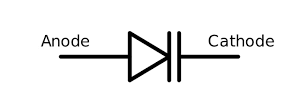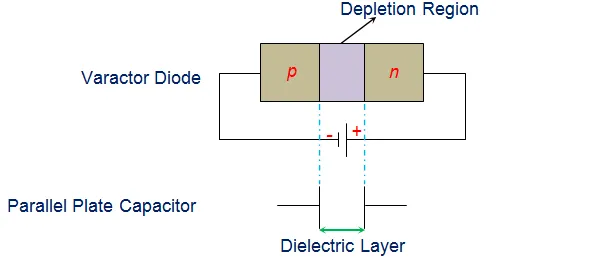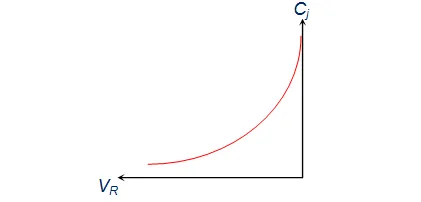A varactor diode, also known as a varicap diode, variable capacitance diode, variable reactance diode, or tuning diode, is a type of diode that uses the voltage-dependent capacitance of a reverse-biased p–n junction to generate current.
A variable capacitor is where the name varactor comes from. The varicap diode only works in reverse bias. Under reverse bias, the varicap diode functions as a variable capacitor.
Index
Varactor Diode Symbol
The symbol for varactor diode is given as

Construction/Working of Varactor Diode
- The semiconductor material used in the Varactor diode is n-type and p-type.
- The majority charge carriers in an n-type semiconductor material are electrons, while the majority charge carriers in a p-type semiconductor material are holes.
- The p-n junction is formed when p-type and n-type semiconductor materials are joined together, and the depletion area is generated at the PN junction.
- The depletion field is made up of positive and negative ions. This region prevents current from flowing through the PN-region.
- In the reverse bias case, though, the width of the depletion area seems to increase as the applied voltage is increased.
- Under these conditions, the p-n junction can be considered to be a capacitor, with the p and n layers representing the capacitor’s two plates and the depletion area acting as a dielectric between them.

Characteristics of Varactor Diode
We can use the same formula of calculating the capacitance of a parallel plate capacitor to calculate the capacitance of a varactor diode.
As a result, the mathematical expression for varactor diode capacitance is given by
\(C_j = \frac{\epsilon A}{d}\)Where,
\(C_j\) is total capacitance at the junction.
\(\epsilon\) is the permittivity of semiconductor material.
\(A\) is the area of the cross-sectional of the junction.
\(d\) is the width of the depletion region.
The relationship between capacitance and reverse bias voltage is as follows:
\(C_j = \frac{CK}{(V_b – V_R)^m}\)
Where,
\(C_j\) is capacitance of the varicap diode.
\(C\) is capacitance of the varicap diode when unbiased.
\(K\) is constant, considered to be 1in this case.
\(V_b\) is barrier potential
\(V_R\) is applied reverse voltage.
\(m\) is material-dependent constant.
We can vary the capacitance of the varactor diode by varying the magnitude of the reverse bias voltage as it varies the width of the depletion region, d.
The capacitance equation also shows that \(d\) is inversely proportional to \(C\). This means that when the depletion area width expands due to a rise in the depletion current, the junction capacitance of the varactor diode decreases.

Varactor diodes are made with the aim of achieving a definite C-V curve, which is achieved by controlling the degree of doping during the manufacturing process.
Varactor diodes can be divided into two groups based on whether the p-n junction diode is linearly or non-linearly doped: abrupt varactor diodes and hyper-abrupt varactor diodes.
Applications
- As compared to other diodes, these varactor diodes are beneficial because they are small, inexpensive, stable, and less resistant to noise.
- As a result, they’re used in FM radio tuning circuits to replace the old model variable capacitor tuning.
- They’re common in the RF design world because they allow you to regulate the capacitance of a circuit with a control voltage. Varactor diodes are used in the RF industry because it gives them an unique capability.
- Varactor diodes are widely used for signal modulation, demodulation and also in Automatic Frequency Controllers (AFCs).
- Varactor diodes are also used in Adjusting bridge circuits and adjustable bandpass filters.
FAQs
Varactor diodes perform like any other diode on a multi-diode meter’s test range. Simply attach the red lead to one leg and the black lead to the other. Reverse the leads if it shows an open. The red lead is on the anode if it indicates continuity (600 ohm – 1k ohm on my 1k range).
The diode’s V-I properties are non-linear, and it only allows current to flow in one direction. The diode allows current to flow and has a very low resistance in forward bias mode. In reverse bias mode, the diode blocks current flow and provides extremely high resistance.
A varactor diode is used for tuning applications and is optimised to provide a capacitance vs voltage relationship. A zener diode is a voltage regulator or a voltage reference that is designed for a very well controlled reverse breakdown voltage.
So we can’t replace them.
